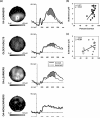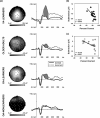Compensatory processing during rule-based category learning in older adults
- PMID: 26422522
- PMCID: PMC4828326
- DOI: 10.1080/13825585.2015.1091438
Compensatory processing during rule-based category learning in older adults
Abstract
Healthy older adults typically perform worse than younger adults at rule-based category learning, but better than patients with Alzheimer's or Parkinson's disease. To further investigate aging's effect on rule-based category learning, we monitored event-related potentials (ERPs) while younger and neuropsychologically typical older adults performed a visual category-learning task with a rule-based category structure and trial-by-trial feedback. Using these procedures, we previously identified ERPs sensitive to categorization strategy and accuracy in young participants. In addition, previous studies have demonstrated the importance of neural processing in the prefrontal cortex and the medial temporal lobe for this task. In this study, older adults showed lower accuracy and longer response times than younger adults, but there were two distinct subgroups of older adults. One subgroup showed near-chance performance throughout the procedure, never categorizing accurately. The other subgroup reached asymptotic accuracy that was equivalent to that in younger adults, although they categorized more slowly. These two subgroups were further distinguished via ERPs. Consistent with the compensation theory of cognitive aging, older adults who successfully learned showed larger frontal ERPs when compared with younger adults. Recruitment of prefrontal resources may have improved performance while slowing response times. Additionally, correlations of feedback-locked P300 amplitudes with category-learning accuracy differentiated successful younger and older adults. Overall, the results suggest that the ability to adapt one's behavior in response to feedback during learning varies across older individuals, and that the failure of some to adapt their behavior may reflect inadequate engagement of prefrontal cortex.
Keywords: Category learning; aging; event-related potentials; rule-based learning.
Figures






Similar articles
-
The effect of age on rule-based category learning.Neuropsychol Dev Cogn B Aging Neuropsychol Cogn. 2006 Sep-Dec;13(3-4):411-34. doi: 10.1080/13825580600574377. Neuropsychol Dev Cogn B Aging Neuropsychol Cogn. 2006. PMID: 16887781
-
Cognitive control adjustments in healthy older and younger adults: Conflict adaptation, the error-related negativity (ERN), and evidence of generalized decline with age.Biol Psychol. 2016 Mar;115:50-63. doi: 10.1016/j.biopsycho.2016.01.008. Epub 2016 Jan 21. Biol Psychol. 2016. PMID: 26802364
-
Cognitive changes in conjunctive rule-based category learning: An ERP approach.Cogn Affect Behav Neurosci. 2018 Oct;18(5):1034-1048. doi: 10.3758/s13415-018-0620-6. Cogn Affect Behav Neurosci. 2018. PMID: 29943175
-
Overcoming Older Adult Barriers to Learning Through an Understanding of Perspectives on Human Information Processing.J Appl Gerontol. 2020 Mar;39(3):233-241. doi: 10.1177/0733464818794574. Epub 2018 Aug 30. J Appl Gerontol. 2020. PMID: 30160573 Free PMC article. Review.
-
The developmental cognitive mechanism of learning algebraic rules from the dual-process theory perspective.Psych J. 2024 Aug;13(4):517-526. doi: 10.1002/pchj.749. Epub 2024 Apr 15. Psych J. 2024. PMID: 38618751 Free PMC article. Review.
Cited by
-
Category learning can alter perception and its neural correlates.PLoS One. 2019 Dec 6;14(12):e0226000. doi: 10.1371/journal.pone.0226000. eCollection 2019. PLoS One. 2019. PMID: 31810079 Free PMC article.
References
-
- Akaike H. A new look at the statistical model identification. IEEE Transactions on Automatic Control. 1974;19(6):716–723. doi:10.1109/TAC.1974.1100705,MR 0423716.
-
- Albert M, Moss MB, Blacker D, Tanzi R, McArdle JJ. Longitudinal change in cognitive performance among individuals with mild cognitive impairment. Neuropsychology. 2007;21:158–169. doi:10.1037/0894-4105.21.2.158. - PubMed
-
- Ashby FG, Alfonso-Reese LA, Turken AU, Waldron EM. A neuropsychological theory of multiple systems in category learning. Psychological Review. 1998;105:442–481. doi:10.1037/0033-295X.105.3.442. - PubMed
-
- Ashby FG, Gott RE. Decision rules in the perception and categorization of multidimensional stimuli. Journal of Experimental Psychology: Learning, Memory, & Cognition. 1988;14:33–53. - PubMed
-
- Ashby FG, Maddox WT. Relations between prototype, exemplar, and decision bound models of categorization. Journal of Mathematical Psychology. 1993;37:372–400. doi:10.1006/jmps.1993.1023.
Publication types
MeSH terms
Grants and funding
LinkOut - more resources
Full Text Sources
Other Literature Sources
Medical
Miscellaneous
